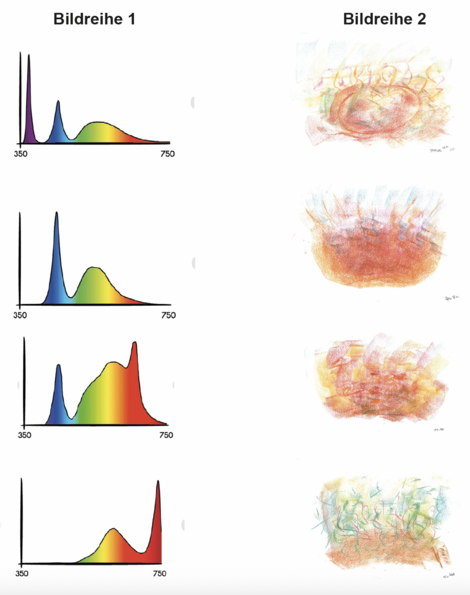Torsten Arncken
In the research project “Effects of the four ethers on the shape, fragrance, and taste of plants”, I am investigating how light with different spectral distributions, corresponding to the different ether types, affects plants.
In 1903, Rudolf Steiner held private esoteric lessons for Marie and Olga von Sivers and Mathilde Scholl. The following is found in the notes: "The sun's rays vibrate in four different etheric forms. They produce heat, light, and chemical effects – in their finest form, they are the substance of life, prana." (GA 91, August 8, 1903, 2018, p. 37 in German)
In sunlight, all four ethers affect the plant. My thesis is that certain spectral ranges make certain ethers more visible in plant growth: ultraviolet, the life ether; the blue spectral range, the chemical ether; the green to red range, the light ether; and infrared, the warmth ether. In the experiments that I have been conducting since 2021, I attempt to amplify each of these four effects of the solar spectrum and observe how plants respond. For this purpose, I have four LED lighting systems, each dominated by one of these ranges (Fig. 1).
Light Affects Shape and Fragrance
Plants show the effect of these spectra in the way they form and produce other substances. This can be seen, for example, in the fragrance. In order to grasp the different effects on fragrance imaginatively, I use a method that Rudolf Steiner suggested in the first college course (1920). The goal is to allow sensory perception to flow into oneself without forming concepts. To make this possible, the perceived fragrances are expressed in colors – they are symbolized. This turns the activity of the will into an organ of perception for imaginative processes. Art becomes part of the research process. The illustrations show an example of this type of observation.
The conclusions drawn from these effects are relevant for anthroposophical medicine and pharmacy, as well as for biodynamic agriculture. The project is being conducted in collaboration with physicians, pharmacists, farmers, and Goetheanists; there is also a collaboration with the University of Basel (CH).
This article was first published in a slightly modified version in Anthroposophy Weltweit, No. 12/2024 (p. 12).
Or via Bank Transfer:
| CHF | EUR | |
| Allgemeine Anthroposophische Gesellschaft Postfach, 4143 Dornach/Schweiz Raiffeisenbank Dornach, CH–4143 Dornach BIC: RAIFCH22 IBAN: CH54 8080 8001 1975 4658 2 ⇨ Payment Purpose: KST 1113 | Allgemeine Anthroposophische Gesellschaft Postfach, 4143 Dornach/Schweiz GLS Gemeinschaftsbank eG, DE-44708 Bochum BIC: GENODEM1GLS IBAN: DE53 4306 0967 0000 9881 00 ⇨ Payment Purpose: KST 1113 |
